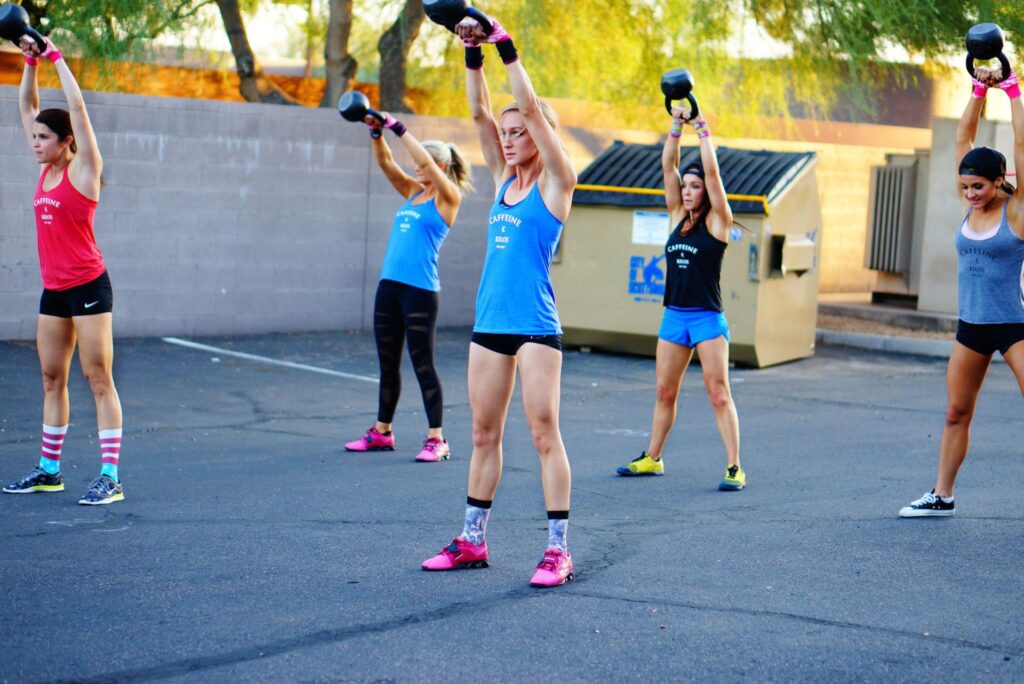Before 2020, people were in the gym multiple times a week, and fitness influencers were showcasing complex workouts on social media. Among the chaos that is the pandemic, we have seen many shifts in society and various industries. After COVID-19, many people are now working out from home, and priorities and consumer behavior have changed.
As society has shifted, marketing needs to adapt to the new normal. There’s a need to shift the marketing narrative to break down current consumer pain points. Safety, sanitation, and health are key concerns in decision-making when it comes to gyms and fitness. Global pandemic or not, marketing has the tendency to move fast with new technologies and techniques emerging regularly. In this article, we try to understand the current state of gym marketing and how you can market your new gym.
Skip ahead to:
- Gym marketing in 2021
- Why you need to get creative with fitness marketing strategies
- 12 fitness marketing ideas for your new gym
Gym marketing in 2021
The marketing world is dynamic. It feels like practically every day some new statistics come to the surface telling you to use one platform over another. That’s why it’s important to stay up to date with the latest marketing and industry trends. After all, your marketing strategy is one of the ways you can stay ahead of the curve, so you don’t fall behind the competition. Whether it’s video, blog, SEO, direct mail, or social media, there’s a lot of spinning wheels in marketing that allow you to stay relevant and connect with customers.
To create an effective marketing plan, health clubs and gyms should try to better understand their customers and the member experience. There’s no such thing as too much information when it comes to understanding who your members are and what they want. Communicating how your business will both help consumers hit their goals and stay safe will be essential. Going forward, it’s a good idea to put focus on your value proposition, marketing message, and innovation in how you overcome customer pain points.
Why you need to get creative with fitness marketing strategies
Factors like cost, distance, and type of gym will always be important factors in deciding to join a gym. But research shows that now some of the top drivers for decision-making are value, convenience, and sanitation. Health clubs will have to market to consumers’ needs to come out on top and stay ahead of the competition.
Creativity is important in all aspects of marketing. It drives authenticity and originality in a very crowded landscape. We all need to draw on our creativity to generate new ideas, push boundaries and engage customers. One main part of this is understanding that our marketing needs to connect with human people. Knowing your gym audience and how your offer is valuable to your target audience will help you to market your gym effectively.
When it comes to the world of marketing, there are several platforms to use. What marketing channels you use really depends on your target audience, budget, goals, and business type. Some of the top marketing methods include:
- Word of mouth
- Social media
- Direct mail
- SEO
- Influencer marketing
- Paid media advertising
For expert insight on sales and marketing, listen to Laurie McCartney, the President of Global Fitness and Wellness Solutions at Ascend Learning. She talks about developing your business for a changing fitness industry and how marketing is going to change.
12 fitness marketing ideas for your new gym
The fitness industry is hugely competitive with new concepts and fitness businesses coming to the table. To succeed in such a fast-paced industry, it’s not enough to be up to date with the latest trends, you need to stay ahead of the game. That means effectively targeting potential customers with a value proposition that is too good to turn down. It means creating inspirational and educational content that positions your brand as an authority. Let’s dive into 12 gym marketing ideas for your new business you can integrate into your marketing campaigns.
1. Referral program
Creating an effective referral marketing strategy can do wonders for your marketing and sales goals. Because you’re more likely to listen to a friend than a business, a referral program can generate new leads. In a referral program, you create an offer for both the referrer and the referee. It’s a way to encourage members to tell their friends and family about your business. If you can turn customers into brand advocates, they can share how great your gym is and why someone should join. A good referral program has the right incentive and takes hardly any effort to join. The whole process should be seamless and always deliver on its promise.
2. Dominate search results
Search marketing uses two strategies: SEO and SEM: Search engine marketing (SEM) is a strategy you can implement to appear in search results. The aim of it is to drive traffic to your website using paid search. Instead, SEO focuses on optimizing your website to drive organic traffic. To dominate the search results, you can tap into SEO and SEM strategies. With paid advertising, you can use pay-per-click to appear at the top of search results. On top of this, you have organic search results. This is where your SEO strategy, social media traffic, local search, links, keywords, and content helps you to rank higher organically.
The Top 10 Barriers
Slowing Your Fitness
Business Growth
Discover more 3. Evaluate your website
A website is an essential business marketing asset. The COVID-19 pandemic accelerated digital adoption in many industries. Yet 28% of small businesses don’t have a website. While 71% of small businesses do have a website, building and maintaining a website is a challenge, especially as customer’s expectations continue to rise. Now is a good time to evaluate your website to see where you could make improvements. Here are some of the top elements your website can include to market your business:
- Fresh content
- Blogs, videos, and podcasts
- Social sharing
- User-friendly design and intuitive navigation
- Mobile-friendly
- Search
- SEO
- Chatbots
- Automation
4. Leverage video
If you’re not using video, you’re missing out on a marketing opportunity. 54% of consumers want to see more video content from a brand or business they follow. Statistics show that viewers claim to retain 95% of the message when obtained through a video. Video is super effective at getting your message across. You can use short and engaging videos on your website, landing page, social media, YouTube, and more. When creating a video for your fitness center, consider your target audience. The great thing about video is that you can tell a story and share a message in a much more digestible format.
5. Start a podcast
Podcast listening and awareness continues to rise in the US. With consumer adoption of smart speakers and an explosion in podcast content, starting a podcast is a great marketing opportunity. 78% of Americans are now familiar with podcasts. Over the last 15 years, the number of podcast listeners has risen. The long-form audio broadcast gives you the opportunity to delve deep into a topic. One of the reasons that podcasts are so popular is the ability to consume them without having to watch anything. You can listen to podcasts in the car, on your commute, or while you cook dinner. Podcasts drive high levels of engagement, build loyal followings, and can be repurposed into other types of content.
6. Share customer success stories
Your customers are proof that your business impacts lives. You help your gym members to achieve their goals and progress their fitness journey. Your members are relatable people instead of perfect Instagram influencers. This is why sharing customer success stories are so valuable in your marketing strategy. Sharing customer stories supports your organic digital marketing strategy. You have the option to share user-generated content as well as include social proof on your website and landing page. Use website testimonials and engage with members on social media after they share their latest workout at your gym.
7. Tap into social media marketing
Your social media marketing strategy can set a strong foundation for your overall marketing plan. When marketing a new gym, social media is your friend. Often, it’s where your members hang out and communicate online. There are an increasing amount of opportunities on social media for fitness centers, gyms, and health clubs. Showcase client success on Instagram Stories and Snapchat, create compelling brand stories on TikTok and use Facebook Stories to build brand awareness. Combine organic social and paid social to make the most out of your social media marketing. Potential clients will look at your social channels to see if you’re the right fit for them. Your social media platforms should show off your personality and unique qualities.
8. Reassure members
The COVID-19 crisis has changed the way people view public places. Being in a crowded location means that it’s tough to socially distance. Things like door handles and dumbbells are now high-touch points that could be a breeding ground for germs. When marketing your new gym, it’s important that you reassure future members on how COVID-safe your environment is. You could do this by doing a video tour with all your cleaning practices and updates. Include all essential information on your website such as temperature checks, COVID-19 procedures, and distancing all equipment. By implementing increased cleaning and hygiene processes and communicating these, you can reassure members.
9. Nurture a virtual community
Your online fitness community is important. It’s the place that members can go for motivation, tips, and connection when they aren’t physically with you. Fitness marketing isn’t just about gym promotion on social media and driving traffic to your website. It’s about creating a network where members can connect with each other. Create private Facebook groups, online forums, and engage with members on social media.
10. Run competitions and challenges
Run competitions and host fitness challenges to both attract new customers and motivate your existing ones. Promote competitions on social media and offer up a prize, giveaway, or free class that encourages new clients to leave contact details with you. On top of this, regular fitness and health challenges can entice new members and help them to hit new fitness and weight loss goals. You can run both in-person and virtual challenges to cater to both your facility and at-home audience.
11. Don’t forget to go live
Whether you’re live on TikTok, Facebook, or Instagram, it gives you the chance to show your audience and target demographic that there is a real human behind your business. You can show your caring, inspiration, authority, and engaging side. In turn, this helps to build trust and authority in your business. What’s great about fitness is that there are tons of options when it comes to live content. You can talk about upcoming changes to the gym, new fitness classes, or give a quick update on how to do certain exercises correctly. Live streaming gives you the ability to really connect with your audience, create a human connection, and answer questions in real-time.
12. Continue to build brand awareness
Brand awareness is an important part of the consumer decision-making process; it’s a crucial element of the customer journey. Brand awareness builds trust and is part of your long-term strategy. Building brand awareness is an ongoing process that should drip down into your marketing and branding decisions. Consistency, clarity, and voice are all part of building brand awareness throughout your marketing communication. Your digital marketing strategy, content marketing, social media, and SEO all support brand awareness.
In summary
We know that the fitness industry is competitive. It takes a lot of work, time, and effort to market a business and find success. Whether you’re opening a new boutique fitness club or running a digital-only yoga studio, marketing is a key to a foundation of success. Even if you’re on a tight marketing budget, you can implement tactics that generate positive business results at a fraction of a cost. Every gym is different and what may work for you may not work for another business. But by understanding your target audience, you can create real human connections and build a marketing strategy that delivers.















